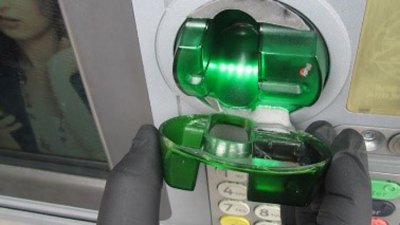Lately, it feels like credit and debit card fraud is impossible to avoid. When your payment information was compromised as a result of a company’s data breach, prevention is out of your control. However, there are several other ways criminals steal your information that you can look out for when using your cards. We’re going to explain two common methods—card skimmers and social media phishing.
Card Skimmers
What is Credit Card Skimming?
Credit card skimming occurs when crooks use small devices in a legitimate card reader to steal and use your information. When your card is swiped through one of these skimmers, the device retains the details that are stored in your card’s magnetic strip. With this information, the crook can buy items online or make a duplicate card. Card skimmers are most commonly place over the legitimate mechanism on ATMs and gas station card readers. They also sometimes place a camera close to the machine to catch all of your information and your pin number.
How Can I Avoid Credit Card Skimmers?
Most credit card skimmers are designed to blend into their area and are hard to detect if you don’t know what you’re looking for. A credit card reader that is sticking out much further than the panel should cause some concern because skimmers are manufactured to fit over the actual reader. To avoid this, pay the cashier inside or drive to a different gas station. Other signs to look at include: part of the card reader being lose or jiggling, a voided security seal, a thick pin pad.
Not only do you have to be on the lookout at ATMs and gas stations, but you have to be cautious online as well.
Social Media Phishing
What is Social Media Phishing?
Social media phishing is when scammers use fake ads and in-app messages to steal your information. An average of 66% of phishing scams on social media are opened by users compared to the 30% that are opened on emails.
What Are Examples of Social Media Phishing?
Fake Accounts: scammers can easily replicate popular websites such as amazon, PayPal, best buy, etc. In 2016, approximately 19% of accounts on social media representing brands were fake. Make sure to check the authenticity of the site and their URL. (For more information, read our article on detecting fraud online.)
- Spam Comments: These comments are left by fake companies often leaving a URL for you to click on in the hopes of you entering a username or password that they can use to hack your other accounts and access your information.
- Direct Messages: Phishing accounts can directly hack you through your DMs, often disguised as your peers or one of the people you follow. This tactic can get you to download malicious files or access malicious websites granting them access to your information in your computer.
- Fake Discounts/Promotions: Scammers can also create fake contest to win prizes in order to get you to give up your personal and card information. These contests can be disguised as a free computer, a $1,000 gift card to your favorite store, or even a 75% off coupon to an expensive online store. Unless this sponsorship is coming directly from the verified social media account of that company, DO NOT click the link or enter in any of your information into the fraudulent site.
With the various ways your information can get compromised nowadays, it can be very difficult to completely avoid fraud. If you find yourself dealing with fraud, make sure to take care of it accordingly and report it. For step by step instructions on what to do if your card is reported for fraud or if you see any suspicious activity, read our article on what to do if your card has fraudulent activity.


